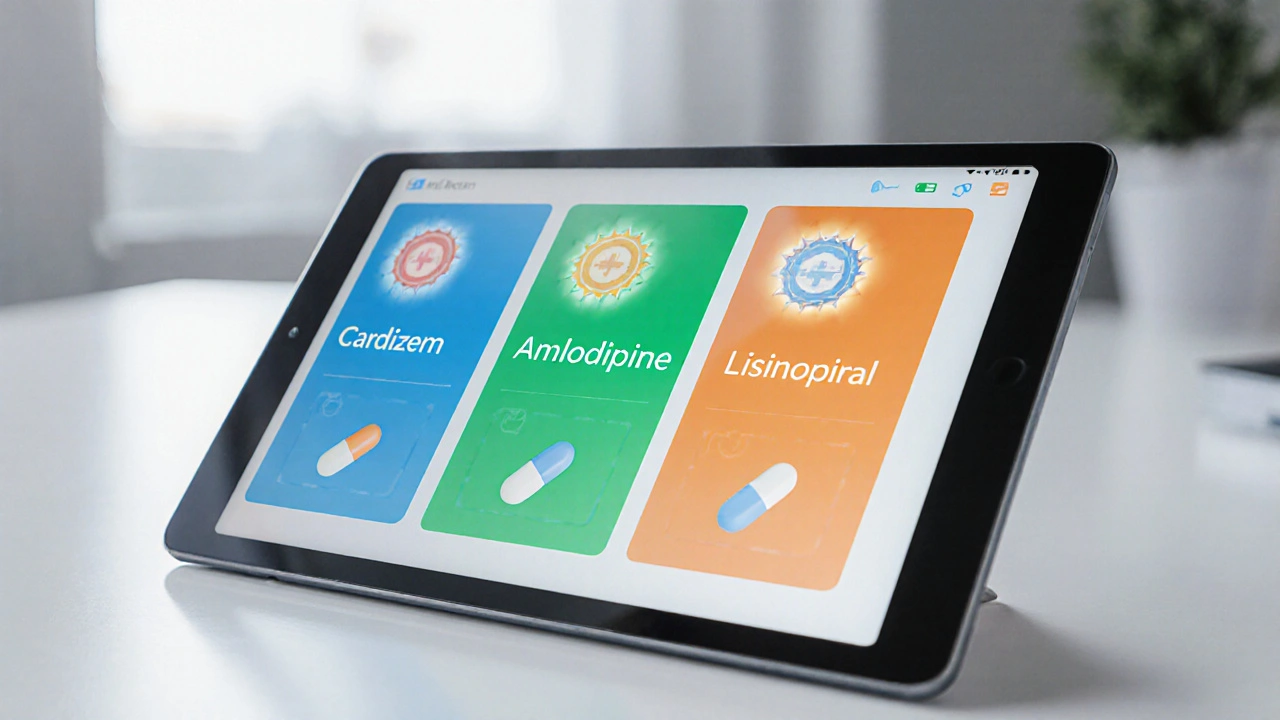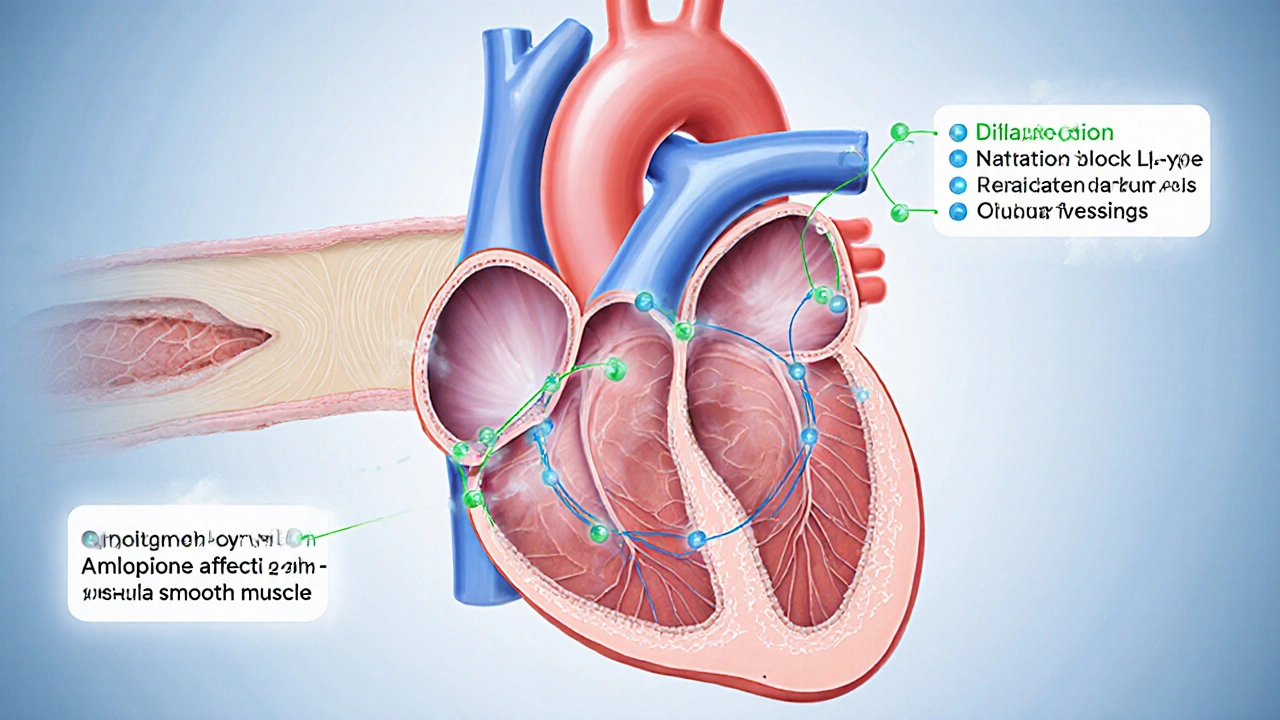
Blood Pressure Medication Comparison Tool
Medication Comparison
About This Comparison
This tool compares Cardizem (diltiazem) with its top alternatives based on clinical use, side effects, and cost. Results are updated based on your selections to highlight the most suitable options for your situation.
Key Takeaways
- Cardizem (diltiazem) is a calcium‑channel blocker used for hypertension, angina, and certain heart rhythm problems.
- Common alternatives include amlodipine, verapamil, lisinopril, and metoprolol, each with different strengths and side‑effect profiles.
- When choosing a medication, consider efficacy for your condition, dosing convenience, cost, and potential drug interactions.
- Most patients can switch safely, but any change should be overseen by a clinician.
- Monitoring blood pressure and heart rate after a switch is essential to ensure the new drug works as intended.
When it comes to managing high blood pressure, Cardizem is a brand name for diltiazem, a calcium‑channel blocker that relaxes the heart and blood vessels. It’s been prescribed for decades, but newer drugs and older alternatives give patients and doctors more options. This guide lines up Cardizem against the most common alternatives, breaking down how they work, who they’re best for, and what to watch out for.
What is Cardizem (Diltiazem)?
Cardizem belongs to the class of medicines known as calcium‑channel blockers (CCBs). Specifically, it is a non‑dihydropyridine CCB, which means it slows the electrical conduction through the heart as well as dilating blood vessels. The drug was first approved in the early 1990s and is available in immediate‑release, extended‑release, and injectable forms.
Key attributes of diltiazem:
- Mechanism: Inhibits L‑type calcium channels in cardiac and vascular smooth muscle.
- Typical dose: 30‑240mg once daily (extended‑release) or 0.25‑0.5mg/kg IV.
- Half‑life: Approximately 3-5hours (short‑acting) or 6-8hours (extended‑release).
- Common side effects: Swelling of ankles, headache, constipation, and bradycardia.
How Cardizem Works: The Pharmacology in Plain English
Diltiazem blocks calcium from entering the cells of the heart and arteries. Calcium is essential for muscle contraction, so fewer calcium ions mean the heart beats slower and the arteries stay relaxed. This dual action makes diltiazem useful for three main problems:
- High blood pressure (hypertension)
- Chest pain caused by reduced blood flow (stable angina)
- Atrial fibrillation or flutter that needs rate control.
Because it slows the heart rate, diltiazem is often chosen over purely vasodilating CCBs when rhythm control is also a goal.
Key Decision Factors When Choosing a Blood‑Pressure or Anti‑Angina Drug
Before you compare alternatives, line up the criteria that matter most:
- Efficacy for your condition: Does the drug lower systolic/diastolic pressure by at least 10/5mmHg? Does it relieve angina episodes?
- Side‑effect tolerance: Some patients can’t handle swelling, others can’t tolerate a dry cough.
- Dosing convenience: Once‑daily pills improve adherence over multiple daily doses.
- Drug interactions: Consider CYP3A4 metabolism, especially with statins or anti‑arrhythmics.
- Cost and insurance coverage: Generic versions of many alternatives are cheaper than brand‑name Cardizem.

Top Alternatives to Cardizem
| Drug | Class | Typical Indication | Key Benefits | Major Side Effects | Typical Cost (CAD) - 30‑day supply |
|---|---|---|---|---|---|
| Cardizem (diltiazem) | Non‑dihydropyridine CCB | Hypertension, Angina, Atrial fibrillation | Controls heart rate+vasodilation | Bradycardia, edema, constipation | $20‑$30 (generic) |
| Amlodipine | Dihydropyridine CCB | Hypertension, Chronic angina | Once‑daily, minimal effect on heart rate | Peripheral edema, flushing, headache | $10‑$15 (generic) |
| Verapamil | Non‑dihydropyridine CCB | Hypertension, Supraventricular tachycardia | d>Strong rate‑control, useful for migrainesConstipation, bradycardia, AV block | $12‑$20 (generic) | |
| Lisinopril | ACE inhibitor | Hypertension, Heart failure | Renoprotective, improves survival in HF | Cough, hyperkalemia, angioedema | $8‑$12 (generic) |
| Metoprolol | Beta‑blocker | Hypertension, Angina, Post‑MI | Reduces myocardial oxygen demand | Fatigue, cold extremities, depression | $10‑$18 (generic) |
Deep Dive Into Each Alternative
Amlodipine - The Smooth‑Operator CCB
Amlodipine is a dihydropyridine calcium‑channel blocker, which means it primarily relaxes arterial smooth muscle without much effect on heart rate. The drug’s half‑life is about 30‑50hours, allowing a simple once‑daily dose of 5-10mg.
Why choose amlodipine?
- Excellent for patients who need strong blood‑pressure control but cannot tolerate a slower heart rate.
- Less likely to cause constipation compared with non‑dihydropyridine CCBs.
- Very low interaction risk with most statins.
Watch for ankle swelling, especially when combined with diuretics.
Verapamil - The Rhythm‑Focused CCB
Verapamil shares diltiazem’s ability to slow conduction through the AV node, making it useful for supraventricular tachycardia and atrial fibrillation rate control. Typical doses range from 80-480mg per day in divided doses.
Key points:
- Effective for patients who need both blood‑pressure reduction and rhythm management.
- Can be used prophylactically for migraine headaches.
- Strong inhibitor of CYP3A4 - watch for interactions with certain anti‑arrhythmics and antibiotics.
Typical side effects include constipation and, in rare cases, heart block.
Lisinopril - The ACE‑Inhibitor Champion
Lisinopril works by blocking the conversion of angiotensin I to angiotensin II, a potent vasoconstrictor. Starting doses are usually 10mg once daily, with a maximum of 40mg.
Why it matters:
- Provides kidney protection for patients with diabetes.
- Improves survival in heart‑failure patients.
- Often cheaper than brand‑name CCBs.
Be prepared for a dry cough in 5‑10% of users, and avoid in pregnant patients.
Metoprolol - The Beta‑Blocker Favorite
Metoprolol blocks beta‑1 adrenergic receptors, reducing heart rate and contractility. It’s commonly prescribed as 50-200mg once daily (extended‑release) or twice daily (immediate‑release).
Main advantages:
- Widely studied for post‑myocardial‑infarction care.
- Helps with anxiety‑related tachycardia.
- Works well when combined with ACE inhibitors.
Potential downsides include fatigue, sexual dysfunction, and worsening of asthma in high doses.
Choosing the Right Medication for Your Situation
Here’s a quick decision tree you can discuss with your clinician:
- If you need both blood‑pressure control and heart‑rate slowing (e.g., atrial fibrillation) → consider diltiazem or verapamil.
- If you prefer a simple once‑daily pill with minimal effect on heart rate → amlodipine.
- If you have diabetes or early kidney disease and want extra renal protection → lisinopril.
- If you’ve had a heart attack or chronic heart failure → metoprolol (often combined with an ACE inhibitor).
Always factor in your current medication list. For example, combining a strong CYP3A4 inhibitor like ketoconazole with diltiazem can raise blood levels dramatically, increasing the risk of bradycardia.
Practical Tips for Switching or Adding a New Drug
- Gradual taper: When moving off diltiazem, a 1‑week taper helps avoid rebound hypertension.
- Monitor vital signs: Check blood pressure and heart rate twice daily for the first week after a change.
- Keep a side‑effect diary: Note any swelling, cough, or fatigue; this guides dose adjustments.
- Ask about generic options: Most alternatives are available at a lower price than brand‑name Cardizem.
When to Call Your Doctor
If you notice any of the following, reach out promptly:
- Sudden drop in heart rate below 50bpm.
- Swelling that doesn't improve after reducing salt intake.
- Persistent dry cough lasting more than two weeks (possible ACE‑inhibitor issue).
- Feeling unusually fatigued or dizzy after a dose change.

Frequently Asked Questions
Can I take Cardizem and amlodipine together?
Combining two calcium‑channel blockers is usually unnecessary and may increase the risk of low blood pressure and edema. Your doctor might adjust the dose of one or switch to a different class instead.
Is diltiazem safe during pregnancy?
Diltiazem is classified as Category C, meaning risk cannot be ruled out. Most clinicians prefer safer alternatives like labetalol or nifedipine for pregnant patients.
Why does Cardizem cause constipation?
The drug reduces smooth‑muscle activity in the gastrointestinal tract, slowing transit. Increasing fiber, water intake, or using a mild stool softener can help.
How does amlodipine differ from diltiazem?
Amlodipine is a dihydropyridine CCB that mainly dilates blood vessels and has little effect on heart rate, whereas diltiazem also slows the heart. This makes amlodipine better for pure hypertension and diltiazem better for rhythm control.
Can I switch from Cardizem to lisinopril without a wash‑out period?
Generally yes. Because they work via different pathways, a short overlap (1-2 days) is safe, but monitoring is essential to avoid sudden blood‑pressure spikes.





17 Comments
Cardizem? Overrated.
Great breakdown! 🎉 This guide makes the maze of BP meds feel way less intimidating. Keep the helpful tables coming!
The comparison nicely highlights each drug's core strengths. It’s useful for anyone weighing side‑effect profiles.
When one surveys the landscape of antihypertensive agents, one encounters a tapestry woven from centuries of biochemical insight.
Cardizem, a non‑dihydropyridine calcium‑channel blocker, occupies a singular niche at the intersection of rate control and vascular relaxation.
Its mechanistic elegance lies in the inhibition of L‑type calcium channels both in myocardial tissue and smooth muscle.
Yet, this very duality invites contemplation about the broader pharmacodynamic symphony of the circulatory system.
One might argue that the drug's modest half‑life encourages adherence, but the counterpoint is the necessity for careful titration.
The side‑effect tableau-bradycardia, peripheral edema, constipation-reflects the intricate balance of ion fluxes across cellular membranes.
In contrast, amlodipine, a dihydropyridine, prefers the arterial bed, sparing the heart's pacemaker cells, which explains its negligible chronotropic effect.
Such distinctions embody the principle that not all calcium antagonists are created equal.
Philosophically, we are reminded that the body is an orchestra, each drug a distinct instrument, resonating at its own frequency.
Thus, selecting a therapy becomes an art as much as a science, demanding a dialogue between clinician and patient.
The cost considerations, while practically paramount, also whisper of socioeconomic determinants that shape therapeutic landscapes.
When one juxtaposes Cardizem against lisinopril, the renin‑angiotensin axis emerges as a competing narrative of renal protection and cough‑induced inconvenience.
Verapamil, sharing Cardizem's class, adds a migrainous facet, suggesting cross‑therapeutic versatility that few agents possess.
Metoprolol, the beta‑blocker, introduces a catecholamine‑centric viewpoint, further enriching the comparative tableau.
Ultimately, the decision matrix is not a static spreadsheet but a living dialogue, evolving with each blood pressure reading.
Therefore, the clinician must wield these data points like a philosopher wields questions-curiously, responsibly, and with humility.
Nice work, very clear.
Looks solid, thanks for the info.
Wow, another exhaustive list-because we totally needed a table with eight columns. 🙄 Also, “diltiazem” is spelled correctly, good job.
Helpful summary.
This is super helpful, thx! I especially liked the side‑effect section, it’s clear. The cost info saves me a trip to the pharmacy. Keep it up!
While the data is presented adequately, the analysis lacks a nuanced discussion of pharmacogenomic implications.
Even if Cardizem feels overhyped, it still has a niche for patients needing both rate control and vasodilation.
Absolutely, the emojis add a nice touch! 😊 The guide is both friendly and thorough.
Sure, because a table is the pinnacle of medical innovation. 🙃
Love the philosophical spin you gave the meds, makes it feel bigger than just pills.
Seriously? You think a philosophical angle adds any real value-stop romanticizing pharmaceuticals!!!
Good point about deeper genetics, though most patients just want to know what works 😊.
All these comparisons ignore the hidden agenda of pharma giants pushing certain drugs to keep profits high.